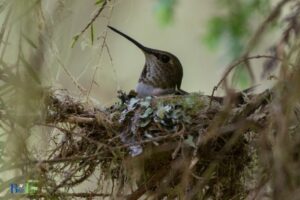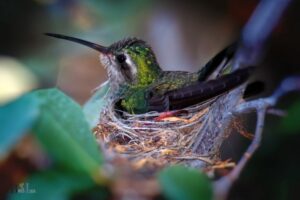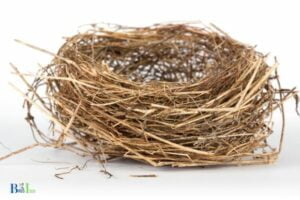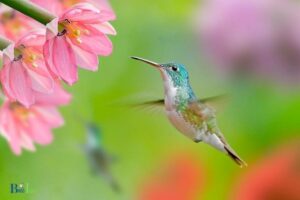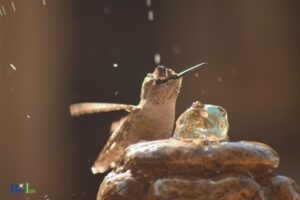Where to Place Hummingbird Nests? 10-15 feet off the ground
To provide an ideal location for hummingbird nests, place them in a sheltered area about 10 to 15 feet off the ground, preferably on horizontal branches with dense foliage.
Hummingbirds are small, delicate creatures, and their nests need to be placed in an environment that offers protection from predators, weather, and human disturbances.
They prefer to build their nests on horizontal branches within a dense foliage cover for added safety and to help camouflage their young.
When selecting a location for hummingbird nests, it’s important to take into consideration the species’ specific needs for safety and comfort.
A well-placed nest will not only benefit the hummingbirds themselves but will also offer you the opportunity to observe these fascinating creatures raising their young.
By following the guidelines mentioned above, you can help create an ideal environment for hummingbirds to thrive and reproduce.
Popular Location to Place Hummingbird Nests
| Environment | Location | Height Range | Additional Features |
|---|---|---|---|
| Forests | Tree branches | 3 – 60 feet | Dense foliage, near food source |
| Gardens | Shrubs or small trees | 3 – 10 feet | Flowering plants, protected from wind |
| Backyards | Porch, awning, or pergola | 3 – 10 feet | Hanging planters, nearby feeder |
| Urban Parks | Dense bushes or trees | 3 – 60 feet | Quiet areas, natural water source |
| Wetlands | Reeds or cattails | 2 – 6 feet | Near water, plenty of insects |
| Urban Areas | Balcony or fire escape | 3 – 10 feet | Flowering plants, sheltered spot |
Key Takeaway
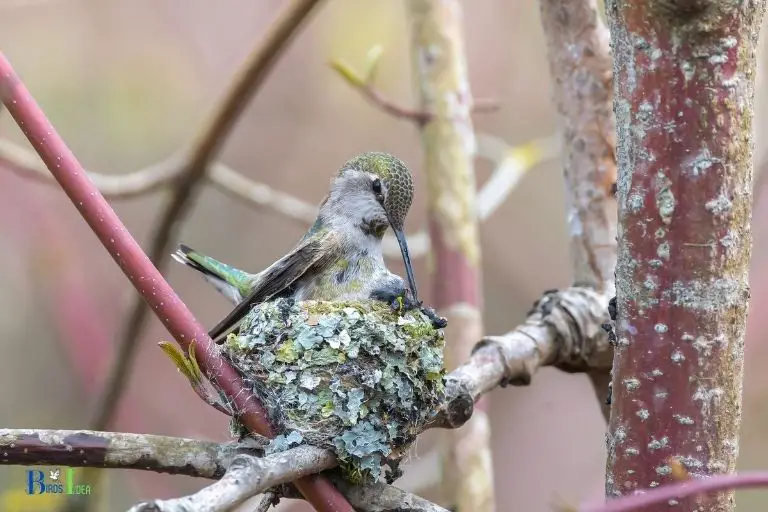
Five Facts About Hummingbird Nests
Understand Hummingbird Behavior And Habitat
Hummingbirds are fascinating, tiny creatures that are known for their agility and beauty. If you’re looking to attract these lovely birds to your garden, then it’s important to understand their behavior and habitat.
In this blog post, we’ll go over the ideal nesting environment for hummingbirds and the factors to consider when choosing a location for your hummingbird nest.
The Ideal Nesting Environment For Hummingbirds
Hummingbirds are known for their love of flowers, but that’s not all they need to thrive.
Here’s what you should know about creating an ideal nesting environment for hummingbirds:
- Shelter: Hummingbirds need a sheltered area to nest where they can be protected from the elements and potential predators. Dense shrubs or trees are great options.
- Security: Hummingbirds prefer to nest in areas that are safe and secure, away from high traffic areas or potential threats such as cats or other predators.
- Food source: Hummingbirds require a continuous supply of food to support themselves and their young. Planting a variety of flowers that bloom at different times can provide a continuous food source.
Factors To Consider When Choosing A Location For Your Hummingbird Nest
Now that you understand what hummingbirds need in their nesting environment, it’s important to consider the factors that will determine the location of your hummingbird nest.
Here are some things to think about:
- Shade or sunlight: Hummingbirds prefer shaded areas to nest, but they also need sunlight to stay warm. Finding a location that has both is ideal.
- Distance from feeders and flowers: Keep your hummingbird nest close to where they feed and forage for food to make it easy for them to fly back and forth.
- Proximity to potential predators: Keep your hummingbird nest away from areas where predators are common, such as near bird feeders or near areas with a lot of foot traffic.
- Accessibility: Make sure your hummingbird nest is in an easily accessible location so you can observe the birds without disturbing them.
Remember, hummingbirds are attracted to safe and secure nesting environments that provide shelter, a constant food supply, and easy accessibility.
Choose a location that meets these criteria, and you’ll be rewarded with beautiful hummingbirds in your garden!
Creating A Hummingbird-Friendly Garden
Tips For Creating A Suitable Habitat For Hummingbirds
Hummingbirds are tiny creatures with a significant impact on the environment. They not only play a crucial role in pollination but also add beauty to your garden.
Here are some tips to help you create a suitable habitat for hummingbirds:
- Provide a variety of blooms for nectar: Hummingbirds feed on nectar and require a diet with a high sugar content. To attract them to your garden, provide a variety of blooms that bloom at different times of the year.
- Create a sheltered environment: Hummingbirds prefer to feel safe while feeding. To create a sheltered environment for your feathered friends, plant shrubs and trees that provide enough shade.
- Provide nesting materials: Hummingbirds are known to build their nests from materials such as spider webs, lichen, and bark. You can provide these materials by growing plants that supply these items.
Selecting The Right Plants And Flowers For Your Garden
The plants and flowers you choose for your garden play a significant role in creating a hummingbird-friendly environment.
Below are some plants and flowers that will attract hummingbirds to your garden:
- Bee balm: This plant produces a lot of nectar, and its red blooms will attract hummingbirds to your garden.
- Cardinal flower: This plant produces bright red flowers that will stand out and attract hummingbirds from a distance.
- Salvia: Hummingbirds and bees love salvia’s nectar-rich flowers, which come in various colors.
- Trumpet vine: This vine’s trumpet-shaped flowers provide a copious amount of nectar that hummingbirds love.
The Importance Of Proper Feeding Stations For Hummingbirds
Besides providing a suitable environment, you must also provide the right feeding stations for hummingbirds.
Here are some things to consider when setting up feeding stations:
- Use the right feeder: Feeding stations come in different styles with different features. Choose a feeder that suits your needs and is easy to clean.
- Use the right nectar: Hummingbirds depend on nectar for their high-energy diet. Avoid using nectar that has been artificially colored and always ensure to use a fresh supply.
- Regular cleaning: To maintain a healthy ecosystem, it is essential to clean the feeding stations regularly. Clean twice a week in warm weather and once a week in colder weather.
By following these tips, you can create a hummingbird-friendly garden that will provide a suitable habitat for these beautiful creatures to hang out.
Remember, hummingbirds are not just charming and fascinating creatures but also play an essential role in pollination, so provide them with the best environment possible.
Choosing The Best Hanging Location For Hummingbird Nests
Where to place hummingbird nests – choosing the best hanging location for hummingbird nests
Hummingbirds are fascinating creatures, and watching them build their nests can be an exciting experience for bird enthusiasts.
However, knowing where to place their nests is crucial to protect the birds from predators, harsh weather, and other hazards.
Here are some tips on choosing the best hanging location for hummingbird nests.
Risk Of Predators And Other Hazards
Predators and other hazards can be a significant risk to hummingbird nests. Therefore, it’s essential to keep their safety in mind when choosing a location for their nests.
Some risks to consider include:
- Predators such as cats, snakes, and squirrels
- Harsh weather conditions such as heavy rains and high winds
- Lack of proper shade and sunlight
- Inadequate space for the nesting birds to fly
The Pros And Cons Of Hanging Nests In Trees, Shrubs, And Structures
Hummingbird nests can be hung from trees, shrubs, or other structures, each with its own pros and cons.
Trees
Trees can be a great option for hanging hummingbird nests. The nest should be attached to the branch, and it should be stable enough to withstand heavy winds and rain.
However, it’s essential to avoid hanging the nest too low as it can become easy prey for predators.
Pros:
- Provides ample shade and sunlight
- Sturdy location
- Natural setting
- Provides ample space for the nesting birds to fly
Cons:
- Prone to predators
- Positioning can be tricky, height must be just right
Shrubs
Shrubs are also another great option for hanging hummingbird nests. The nest ought to be placed in a dense part of the shrub to make it less visible to predators.
Pros:
- Provides ample shade and sunlight
- Provides a natural setting
- Offers protection from predators
- Adequate space for the nesting birds to fly
Cons:
- Prone to harsh weather conditions, particularly strong winds
Structures
Hanging hummingbird nests in structures, such as patios or eaves, can provide protection from predators and harsh weather conditions. The nest should be placed in an area where it can hang without any disturbance.
Pros:
- Provides ample shade and sunlight
- Offers protection from predators
- Provides ample space for nesting birds to fly
Cons:
- Lack of natural setting
- Needs a strong foundation, and it can be difficult to hang
The Ideal Height And Distance Between Nests
The ideal height and distance between nests should be taken considerately to increase the chances of mating activities.
The nest should be high enough to protect the birds from predators but not too high that it becomes challenging to access. The distance between the nests should be kept at least ten feet apart to provide ample space for the hummingbirds to fly.
Hummingbird nests can be a great way to observe these fascinating creatures in action. However, choosing the best hanging location for them is crucial to ensure their safety and increase mating chances.
By considering the risks, the pros and cons of different locations and the distances between nests, hummingbirds can thrive in their nesting environment.
Maintaining And Monitoring Hummingbird Nests
The Frequency And Importance Of Nest Checkups
Regular nest checkups are vital for maintaining healthy hummingbird populations.
Here’s what you need to know:
- Check the nests at least once a week during breeding season
- Check once a month outside of breeding season
- Check with binoculars to avoid disturbing the nest
- Monitor nest temperature and ensure that it does not get too hot
- Observe the behavior of the mother bird and ensure that she is feeding her chicks
Common Nesting Problems And How To Address Them
Unfortunately, hummingbirds can be susceptible to a range of nesting problems, but with a little care, most of these issues can be addressed:
- Parasites: Remove any eggs that are infected with parasites and clean the nest thoroughly
- Abandoned nest: Dispose of any abandoned eggs and wait for the mother bird to build a new nest
- Nest predators: Place the nest in a safe location, out of reach of potential predators like cats or squirrels
- Inadequate nest material: Provide additional nest material, such as soft plant fibers or spider webs, to help the birds build a sturdy nest.
Best Practices For Nest Cleanup And Maintenance
Proper cleaning and maintenance of hummingbird nests can go a long way in ensuring successful breeding.
Here’s what you need to do:
- Wait until the breeding season is over before cleaning the nest
- Use warm water and a mild detergent to clean the nest
- Thoroughly rinse and dry the nest before replacing it
- If the nest is damaged or dirty, replace it with a clean one
- Use a clothespin or small clamp to reattach the nest to its original location
By following these simple tips, you can help maintain healthy and thriving hummingbird populations in your area.
Remember to always be respectful of these delicate creatures and their environments, and to carefully follow all guidelines for monitoring and maintaining their nests.
FAQ On Hummingbird Nests
Where Do Hummingbirds Build Their Nests?
How Can I Identify A Hummingbird Nest?
Can I Move A Hummingbird Nest?
How Long Does It Take For Hummingbird Eggs To Hatch?
Conclusion
After reading this post, we can conclude that proper placement is essential for providing a safe and comfortable environment for hummingbirds to build their nests. The ideal location for nesting should be shaded, protected from predators and extreme weather conditions, and away from human disturbance.
We should also aim to provide the necessary resources such as food, water, and nesting materials. Additionally, by monitoring the nesting site, we can ensure that the hummingbirds are able to successfully hatch and raise their young. It is crucial that we respect these delicate yet hardworking creatures and play our part in conserving them.
By following these simple guidelines, we can provide a suitable home for hummingbirds and contribute to their survival and well-being. So, let’s get started and become a part of the effort to protect these fascinating little creatures.

